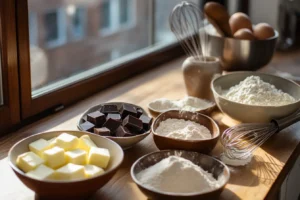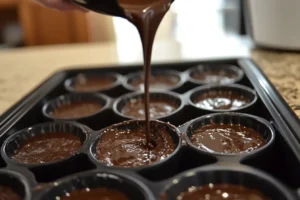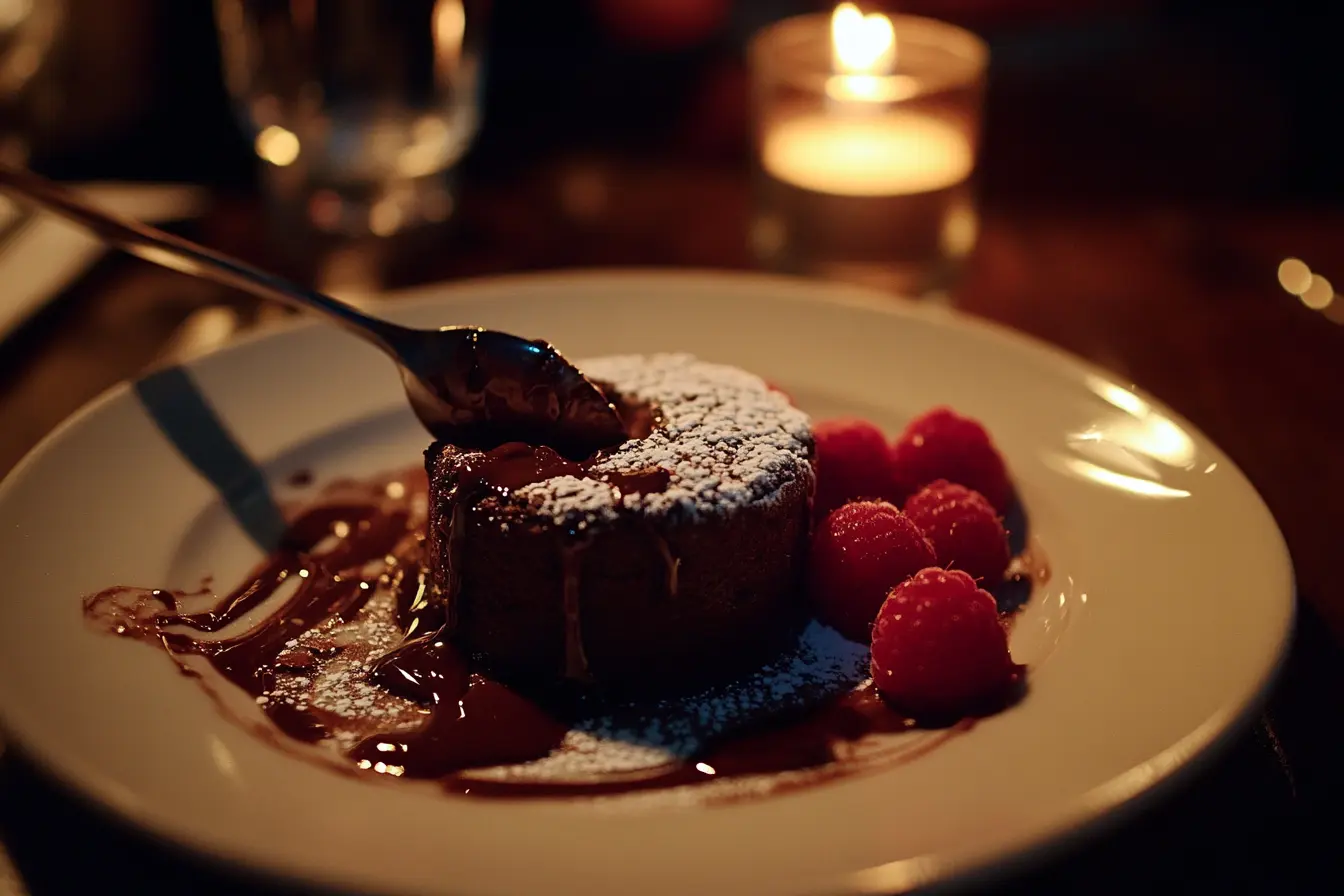Chocolate fondant, also known as molten chocolate cake, is a dream come true for dessert lovers. With its soft outer layer and irresistible gooey chocolate center, this indulgent treat is perfect for any occasion. Whether you’re a seasoned baker or just starting out, mastering this classic dish is easier than you think!
In this ultimate guide, you’ll discover the secrets behind making the perfect chocolate fondant, from selecting the right ingredients to achieving the perfect bake. We’ll explore exciting flavor variations, serving suggestions, nutritional considerations, and answer frequently asked questions to ensure your chocolate fondant turns out perfect every time!
Now, let’s dive into the first part, the history and origin of this beloved dessert!
Introduction to Chocolate Fondant
The Origin and History of Chocolate Fondant
Ever wondered where this decadent dessert comes from? Chocolate fondant has a fascinating history that dates back decades. While many believe the recipe originated in France, some claim that it was actually an accidental discovery by a chef who underbaked his chocolate cake—leading to the rich, molten center we now adore.
Regardless of its exact roots, one thing is clear: chocolate fondant has taken the culinary world by storm! It’s now a staple in high-end restaurants, home kitchens, and bakeries across the globe. The alluring combination of a soft cake exterior and a rich, velvety chocolate core makes it a top choice for dessert enthusiasts.
Popularity and Variations Across the Globe
The magic of chocolate fondant lies in its versatility. While the classic version features a deep chocolate flavor, bakers worldwide have put their own spin on it. In Japan, you might find matcha-infused versions, while in Italy, variations with espresso or hazelnuts are common. Some recipes even swap flour for almond meal to create a gluten-free version, allowing more people to indulge!
Thanks to its adaptability, chocolate fondant can be customized to suit different tastes and dietary needs. Whether you like it intensely dark, subtly sweet, or somewhere in between, there’s a version out there for you!
Essential Ingredients for the Perfect Chocolate Fondant
Creating a flawless chocolate fondant isn’t just about following the right steps—it all begins with selecting high-quality ingredients. Each component plays a vital role in achieving that perfectly baked exterior and irresistibly gooey center. Let’s break down what you need and how each ingredient contributes to the magic of this dessert.
Selecting the Right Chocolate: Dark vs. Milk
 The star of any chocolate fondant recipe is, without a doubt, chocolate. But not all chocolate is created equal! If you want a rich, intense chocolate flavor, dark chocolate (at least 70% cocoa) is your best bet. It melts beautifully, delivers deep flavor, and balances the sweetness of the dessert.
The star of any chocolate fondant recipe is, without a doubt, chocolate. But not all chocolate is created equal! If you want a rich, intense chocolate flavor, dark chocolate (at least 70% cocoa) is your best bet. It melts beautifully, delivers deep flavor, and balances the sweetness of the dessert.
On the other hand, if you prefer a milder, creamier taste, milk chocolate can work, but keep in mind that it contains more sugar and less cocoa, which can alter the texture. For those who enjoy a touch of elegance, experimenting with ruby or white chocolate variations can add a creative twist.
The Role of Butter and Eggs in Achieving the Ideal Texture
Butter and eggs are crucial in chocolate fondant. But why? Butter doesn’t just add richness, it also ensures a smooth, silky texture by emulsifying with the chocolate. Using unsalted butter is best, as it gives you full control over the flavor.
Eggs, on the other hand, act as the binding agent. They help the batter hold its structure while allowing the center to remain soft and molten. Many bakers prefer extra-large eggs for added moisture. If you want a lighter texture, try using one whole egg and one additional yolk instead of two full eggs.
Importance of Sugar and Flour in the Recipe
Sugar isn’t just about sweetness—it’s essential for balance. It not only enhances the chocolate flavor but also contributes to the cake’s tenderness. White granulated sugar is the go-to choice, though brown sugar can add a deeper, caramel-like undertone.
Now, let’s talk flour. The key to a perfect fondant texture is using just enough flour to give structure, without making the cake too dense. Cake flour or all-purpose flour works best, but for a gluten-free alternative, you can opt for almond or oat flour.
Step-by-Step Guide to Making Classic Chocolate Fondant
Now that we’ve covered the essential ingredients, it’s time to bring everything together and create the perfect chocolate fondant. While the process may seem intimidating at first, it’s actually quite simple, especially when you follow the right steps. So, let’s get started!
Preparing the Molds: Greasing and Dusting Techniques
 First things first, prepping your molds is crucial. If you skip this step, your fondants might stick, ruining their shape when you try to unmold them. Here’s what you need to do:
First things first, prepping your molds is crucial. If you skip this step, your fondants might stick, ruining their shape when you try to unmold them. Here’s what you need to do:
- Generously grease each mold with unsalted butter. Make sure to coat every inch to prevent sticking.
- Dust with flour or cocoa powder, depending on your preference. Cocoa powder blends better with the batter, avoiding white streaks on the finished cakes.
- Tap out excess flour or cocoa, ensuring only a thin, even layer remains.
Once your molds are prepped, set them aside and move on to the chocolate mixture.
Melting Chocolate and Butter: Methods and Tips
Getting the right melted chocolate consistency is essential for a smooth, velvety batter. There are two easy ways to do this:
- Double Boiler Method: Place a heatproof bowl over a pot of simmering water. Add chopped chocolate and butter, stirring gently until fully melted. This method prevents overheating and ensures even melting.
- Microwave Method: Place chocolate and butter in a microwave-safe bowl. Heat in 20-second intervals, stirring after each burst until completely melted. Be careful—chocolate burns easily!
Whichever method you choose, let the melted chocolate cool slightly before moving to the next step.
Mixing the Batter: Combining Ingredients for Optimal Consistency
Now, let’s bring everything together:
- Whisk eggs and sugar in a mixing bowl until the mixture turns pale and slightly frothy. This step helps create a light, airy texture.
- Slowly add the melted chocolate mixture, stirring continuously to avoid scrambling the eggs.
- Gently fold in the flour, using a spatula instead of a whisk. Overmixing can make the fondant too dense, so mix just until combined.
At this point, your batter should be smooth, thick, and glossy—exactly what you need for the perfect chocolate fondant.
Baking to Perfection: Time and Temperature Guidelines
The secret to that irresistible molten center lies in the baking time and temperature. Here’s what to do:
- Preheat your oven to 200°C (392°F). A properly heated oven ensures even baking.
- Fill each mold about ¾ full to leave space for the batter to rise.
- Bake for 10–12 minutes. The edges should be set while the center remains soft and gooey.
Once baked, let them rest for 1–2 minutes, then gently run a knife around the edges before inverting onto a plate. The moment you cut into it, that luscious molten center should ooze out perfectly!
Exploring Flavor Variations and Enhancements
While the classic chocolate fondant is undeniably delicious, why not take it up a notch? By experimenting with different flavors, you can create a unique twist that suits your taste. Whether you prefer a subtle hint of spice or a surprising burst of fruity goodness, these variations will add excitement to your dessert. Let’s dive into some creative ways to enhance your chocolate fondant!
Incorporating Spices: Cinnamon, Chili, and More
Spices can transform the flavor of your molten chocolate cake with just a pinch. They add depth, warmth, and an unexpected twist. Here are some fantastic spice options:
- Cinnamon: Adds a mild, comforting warmth that pairs beautifully with dark chocolate.
- Chili Powder: Just a dash creates a subtle heat that intensifies the richness of the chocolate.
- Cardamom: Introduces an aromatic, slightly citrusy note that makes the dessert feel exotic.
- Nutmeg: A tiny sprinkle enhances the fondant’s depth without overpowering the chocolate.
To incorporate spices, mix them into the dry ingredients before folding them into the batter. This ensures even distribution without clumping.
Adding Fruity Twists: Berries, Citrus, and More
If you love the combination of fruit and chocolate, you’re in for a treat! A little fruit can elevate the fondant’s flavor and add a refreshing contrast to its richness. Here’s how:
- Raspberry or Strawberry Puree: Swirl it into the batter before baking for a tangy, vibrant touch.
- Orange or Lemon Zest: A small amount enhances the chocolate’s natural flavors with a hint of citrusy brightness.
- Chopped Cherries or Blueberries: Mix them directly into the batter for juicy bursts of sweetness.
For an extra layer of flavor, consider drizzling fruit coulis over the fondant before serving.
Using Different Types of Chocolate: White and Ruby Chocolate Fondants
Switching up the type of chocolate you use can create an entirely different dessert experience. While dark chocolate is the standard choice, these alternatives offer exciting variations:
- White Chocolate Fondant: Sweeter and creamier, this version is perfect for those who prefer a milder flavor.
- Ruby Chocolate Fondant: With its natural berry-like taste, ruby chocolate brings a tangy, colorful twist to the traditional recipe.
- Milk Chocolate Fondant: Softer and more delicate, this version creates a silkier texture that melts in your mouth.
Experimenting with Nutty Additions
Nuts can add crunch and a delightful contrast to the fondant’s soft texture. Try these options:
- Almond or Hazelnut Flour: Swap part of the all-purpose flour with finely ground nuts for a subtle, nutty taste.
- Chopped Pecans or Walnuts: Mix them into the batter for an added crunch.
- Crushed Pistachios: Sprinkle on top before serving for an elegant finish.
Serving Suggestions and Accompaniments
Now that you’ve mastered the art of baking chocolate fondant, it’s time to talk about presentation and pairings. While this dessert is already a showstopper on its own, the right accompaniments can enhance its flavor, texture, and overall experience. Whether you want a classic pairing or a creative twist, these serving ideas will elevate your molten chocolate cake to a whole new level!
Pairing with Ice Creams and Sorbets
Few things complement warm, gooey chocolate fondant better than a scoop of ice cream. The contrast between hot and cold creates a sensational balance that delights the taste buds. But which flavors work best?
- Vanilla Bean Ice Cream: A timeless pairing that allows the chocolate to remain the star of the dish.
- Salted Caramel Ice Cream: Adds a hint of saltiness, cutting through the richness for a well-rounded bite.
- Espresso or Mocha Ice Cream: Perfect for coffee lovers, this combination enhances the deep cocoa notes.
- Berry Sorbet: A tangy and refreshing alternative that lightens the dessert without overpowering it.
If you’re feeling adventurous, try making homemade ice cream or sorbet for a personal touch!
Garnishing with Fresh Fruits and Berries
Adding fresh fruit isn’t just about aesthetics, it also provides a natural sweetness and acidity that balances the richness of the chocolate fondant. Some great options include:
- Raspberries and Strawberries: Their tartness pairs beautifully with deep chocolate flavors.
- Sliced Bananas: Adds creaminess and a naturally sweet contrast.
- Pomegranate Seeds: Offers a burst of juice and an elegant touch.
- Orange Slices or Zest: A citrusy kick that brightens up every bite.
To make the presentation even more appealing, try arranging the fruits in a circular pattern around the fondant for a professional look.
Drizzling Sauces: Caramel, Raspberry Coulis, and More
A silky drizzle of sauce can take your chocolate fondant from delicious to utterly irresistible. Depending on your preference, here are some fantastic choices:
- Classic Chocolate Sauce: For those who can never get enough chocolate!
- Salted Caramel Drizzle: A rich and buttery contrast that melts into the warm fondant.
- Raspberry or Strawberry Coulis: Adds a fruity tartness that enhances the chocolate’s depth.
- Peanut Butter or Hazelnut Spread: A nutty twist that makes the fondant even more indulgent.
If you want to elevate the experience further, try warming the sauce slightly before drizzling it over the dessert.
Dusting with Powdered Sugar or Cocoa
A simple dusting of powdered sugar or cocoa powder can add elegance to your presentation. Lightly sifting sugar over the top creates a delicate, snowy effect, while cocoa powder intensifies the chocolate aroma. You can also use a stencil to create intricate designs for an impressive finish.
Serving on Elegant Plates with Complementary Elements
Presentation matters! Serve your chocolate fondant on a sleek white plate for contrast, or use textured ceramic plates for a rustic feel. Adding elements like edible gold leaf, crushed nuts, or chocolate curls can further enhance the visual appeal.
Nutritional Information and Considerations
While chocolate fondant is a decadent dessert, it’s still possible to enjoy it while being mindful of nutrition and dietary needs. Understanding its caloric content, macronutrient breakdown, and possible modifications can help you make informed choices. So, whether you’re watching your sugar intake or looking for allergy-friendly options, this section covers everything you need to know!
Caloric Content and Macronutrient Breakdown
A typical serving of chocolate fondant (about 100 grams) contains approximately:
- Calories: 350–450 kcal
- Carbohydrates: 40–50g (mostly from sugar and flour)
- Fats: 20–25g (from butter and chocolate)
- Proteins: 5–7g (mainly from eggs)
Since chocolate fondant is high in fats and sugars, it’s best enjoyed in moderation. However, if you want to make it a little healthier, there are plenty of easy swaps!
Tips for Reducing Sugar and Fat Without Compromising Taste
You don’t have to give up flavor to make your chocolate fondant slightly lighter. Here are some smart ingredient swaps to maintain richness while lowering sugar and fat content:
- Use dark chocolate (85% cocoa or higher): It contains less sugar and more antioxidants than milk chocolate.
- Replace some of the butter with Greek yogurt or mashed avocado: Both options reduce fat while keeping the texture smooth.
- Swap refined sugar for coconut sugar or honey: These alternatives have a lower glycemic index and add natural sweetness.
- Use almond flour instead of all-purpose flour: It adds protein, fiber, and a nutty flavor while making the dessert gluten-free.
With these modifications, you can still enjoy a luscious molten chocolate cake without overloading on sugar and unhealthy fats.
Allergen Information and Substitutions for Dietary Restrictions
For those with dietary restrictions, chocolate fondant can be easily adapted to suit different needs:
- Gluten-Free: Swap wheat flour for almond, coconut, or oat flour to maintain structure without gluten.
- Dairy-Free: Use coconut oil or dairy-free butter alternatives, and opt for a dairy-free chocolate brand.
- Egg-Free: Substitute eggs with flaxseed or chia egg (1 tbsp ground flaxseed + 3 tbsp water per egg) to retain the right consistency.
- Low-Sugar: Reduce sugar or use monk fruit sweetener, stevia, or erythritol for a lower-carb version.
These small tweaks ensure that more people can enjoy chocolate fondant, regardless of their dietary needs.
Is Chocolate Fondant a Healthy Dessert Choice?
While chocolate fondant isn’t exactly a “health food,” dark chocolate provides antioxidants, and using quality ingredients can make a difference. As long as you enjoy it in moderation, it can fit into a balanced diet without guilt.
Frequently Asked Questions About Chocolate Fondant
Whether you’re making chocolate fondant for the first time or trying to perfect your technique, you probably have a few questions. From avoiding common mistakes to storing leftovers, this section covers everything you need to know.
How Can I Prevent My Fondant from Overcooking?
Overcooking is one of the biggest challenges when making molten chocolate cake. If baked too long, the center won’t stay gooey, which takes away its signature texture. To prevent this:
- Stick to the recommended baking time (10–12 minutes at 200°C/392°F).
- Use an oven thermometer to ensure accuracy—many ovens run hotter or cooler than their settings.
- Check for doneness by gently pressing the sides—they should be firm, while the center should remain slightly soft.
Can Chocolate Fondant Be Made Ahead of Time?
Yes! You can prepare the batter a few hours or even a day in advance. Simply follow these steps:
- Make the batter and pour it into the molds.
- Cover with plastic wrap and refrigerate for up to 24 hours.
- When ready to bake, let the molds sit at room temperature for 10–15 minutes before putting them in the oven.
This method is perfect when you’re hosting a dinner party and want a fresh-baked dessert without the last-minute prep.
What Are Common Mistakes to Avoid When Making Chocolate Fondant?
Even though chocolate fondant is simple, a few mistakes can ruin the texture. Here’s what to watch out for:
- Skipping the mold preparation: Without greasing and dusting, the fondants might stick, making them impossible to remove cleanly.
- Overmixing the batter: Too much mixing can develop gluten in the flour, leading to a dense, chewy texture.
- Using the wrong chocolate: Poor-quality chocolate won’t melt properly, affecting the flavor and consistency.
- Baking at the wrong temperature: If the oven is too hot, the outside will set too quickly while the center remains too liquid.
By avoiding these mistakes, you’ll achieve that perfect molten center every time!
How Do I Store Leftover Chocolate Fondant?
If you happen to have leftovers (though that’s rare!), here’s how to store them properly:
- Refrigerate: Keep fondants in an airtight container for up to 3 days.
- Reheat: Warm them in the microwave for 15–20 seconds or in a low-temperature oven (150°C/300°F) for a few minutes.
- Freeze: Place cooled fondants in a freezer-safe container and store them for up to 3 months. When ready to eat, thaw in the fridge overnight and reheat gently.
Keep in mind that reheated fondants may not have the same gooey center, but they’ll still taste incredible!
Can I Make a Gluten-Free Version of Chocolate Fondant?
Absolutely! Many people successfully make gluten-free chocolate fondant by swapping regular flour for:
- Almond flour (adds a nutty richness)
- Oat flour (gives a mild flavor and light texture)
- Coconut flour (absorbs more moisture, so use slightly less)
Since gluten-free flours behave differently, you may need to experiment with ratios to get the right consistency. But the result? Still just as indulgent and delicious!
What Is the Difference Between Chocolate Fondant and Molten Lava Cake?
Although many people use the terms interchangeably, chocolate fondant and molten lava cake aren’t exactly the same. Here’s the main difference:
- Chocolate Fondant is a carefully baked dessert with a soft, sponge-like exterior and a naturally molten center.
- Molten Lava Cake often relies on underbaking to create the gooey middle, making it slightly riskier to get right.
Both are irresistibly chocolatey, but fondant tends to be more structured and refined.

